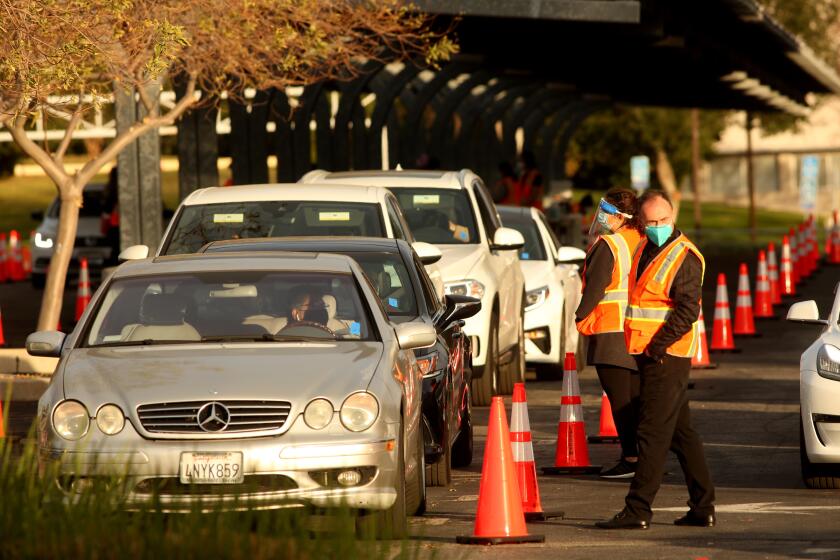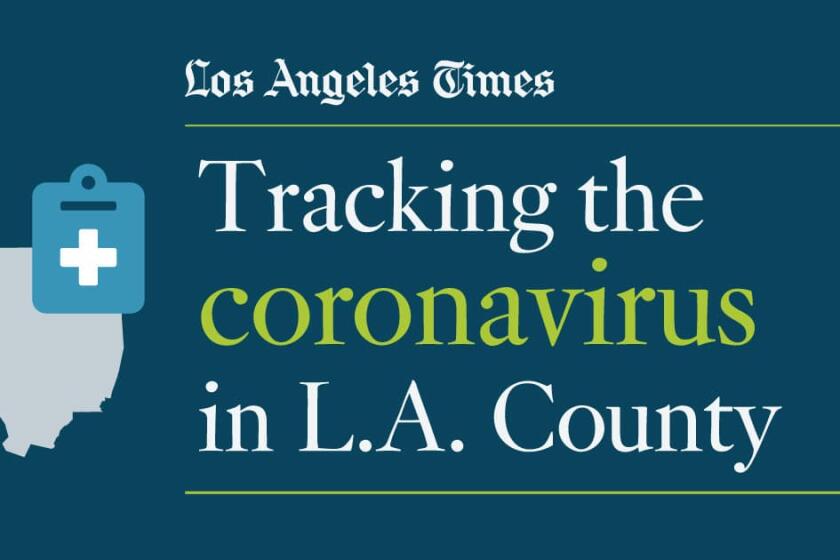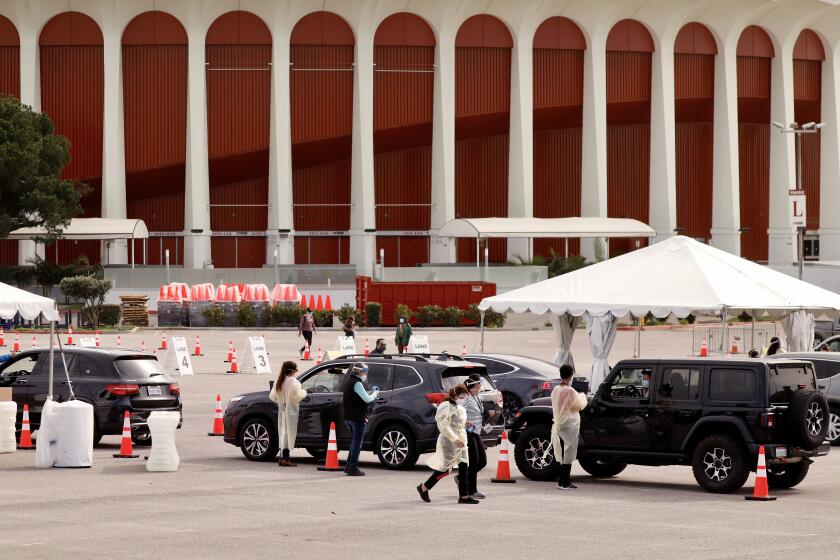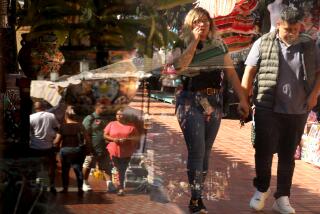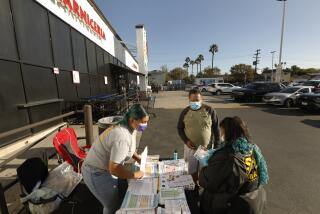‘The end is not yet in sight’: Coronavirus danger remains even as some metrics improve, L.A. County says

Despite some promising signs that the worst wave of the COVID-19 pandemic may finally be receding, a top Los Angeles County health official warned Wednesday that the situation remains precarious, with thousands more people becoming infected every day and an unsustainable number of patients requiring hospital treatment.
“The end is not yet in sight,” county Public Health Director Barbara Ferrer said.
Though the county has recently seen welcome downticks in the number of coronavirus-positive patients in its hospitals, as well as the daily infection rate, Ferrer emphasized that “COVID-19 is still rampant at our workplaces, in our neighborhoods and, really, across every corner of this county.”
“While more people are being vaccinated, it’s important to remember that we do have a long road in front of us before we say goodbye to COVID-19,” she said.
On Tuesday in Los Angeles County, those 65 and older began signing up for COVID-19 vaccine appointments. But it will take time to inoculate everyone.
Still, there are some signs that the road ahead may not be as arduous.
Over the past week, the county has reported an average of 11,369 new cases per day — down 25% from the seven-day period that ended on Jan. 13, when L.A. County was averaging 15,102 cases a day, according to data compiled by The Times.
It remains too soon to say whether that’s a blip or the start of a new trend, however, as recent case numbers are likely warped by the closure of testing sites and delays in data reporting over the Martin Luther King Jr. Day weekend. Testing capacity has also declined with the conversion of Dodger Stadium into a vaccination site.
Ferrer, though, said that “we are very hopeful that the actions taken by many are starting to work,” and that coronavirus transmission rates are finally starting to drop.
Even if the decrease is legitimate, officials said it’s only a fraction of what’s needed to relieve the stress on overwhelmed hospitals and overworked healthcare staff. As Ferrer noted, “With high numbers of daily cases, hundreds more people will require hospitalization every week.”
COVID-19 hospitalizations have also tailed off, though they remain far too high to provide any real comfort. There were 7,263 coronavirus-positive patients hospitalized countywide Tuesday, according to the latest available state data, which is down about 10% from the record high of 8,098 set on Jan. 5.
The number of COVID patients requiring intensive care, however, has remained relatively flat over that same period — falling to 1,692 on Tuesday, down just 2% from the record high of 1,731 set on Jan. 8.
The latest maps and charts on the spread of COVID-19 in Los Angeles County, including cases, deaths, closures and restrictions.
Though the decrease in total hospitalizations is “bringing some much-needed relief,” Ferrer said, “it’s nowhere near the number that we need to get down to, to really avoid all of the changes that needed to be made at hospitals to accommodate” the crush of patients.
But every day that passes with the numbers remaining flat or even trending lower breeds optimism that the county may be emerging from its post-Christmas surge.
While it appears less severe than the post-Thanksgiving surge, Ferrer said she doesn’t believe “we dodged a bullet because our hospitals are still overwhelmed, and I think we did still see some increase in cases from the holiday season.”
Ferrer said she does “feel confident at this point that we may really be seeing less transmission in our communities as we move forward. [It’s] nowhere near low enough to breathe a sigh of relief because all the numbers are too high, but it does maybe mean we can stabilize and hopefully start seeing a significant decline.”
Five large-scale vaccination sites opened across Los Angeles County on Tuesday.
At the state level, officials have expressed some cautious optimism.
Over the seven-day period that ended Wednesday, the state has averaged about 33,000 new cases per day, significantly below the roughly 45,000 seen earlier this month, Times’ data show.
Still, some officials have urged against reading too much into that number. Case rates have oscillated the past few weeks, as holidays have temporarily closed testing sites and delayed reporting results.
“It may still be that we will see some additional cases that could come up from the New Year’s timing,” Dr. Robert Kim-Farley, a medical epidemiologist and infectious diseases expert at the UCLA Fielding School of Public Health, said Tuesday. It would be wise, he said, “before getting too optimistic to let a few more days go by to make sure we have complete reporting for this most recent period of time.”
But, he added, “cautious optimism may be in order.”
One promising data point is that the rate at which tests are confirming infection — a key indicator of coronavirus spread — has fallen.
In the first week of January, about 14.3% of tests in California were coming back positive, the highest proportion since April. That seven-day positivity rate had fallen to 9.7% as of Wednesday, according to state data. (In L.A. County, the daily positivity rate has fallen from 20% around New Year’s Eve to 14% by Wednesday.)
The number of COVID-19 patients hospitalized statewide has also tumbled, and on Tuesday it fell below 20,000 for the first time since Dec. 27.
Of the 19,979 coronavirus-positive patients in California’s hospitals, 4,682 are in intensive care units.
California’s COVID-19 hospitalizations reached a peak about two weeks ago, on Jan. 6, hitting 21,938. The number of COVID-19 patients in ICUs statewide crested Jan. 10, when there were 4,868.
Dr. Mark Ghaly, California’s health and human services secretary, said the state “didn’t see as significant of a bump over the Christmas and New Year holidays” as expected and, though there could still be some variance, officials are hopeful the number will continue to trend downward.
“Hopefully, by the end of the month, we’re even lower than the number that we see here,” he said Tuesday. “So that’s great news, given that we were anticipating being well above 25,000 admissions in our hospitals across the state.”
Vaccines, aggressive strains and fatigue: California hits 3 million COVID cases and a crossroads.
But many Californians are still paying the pandemic’s ultimate price.
On Wednesday, health departments statewide confirmed that 617 more Californians had died from COVID-19, the sixth highest daily total to date, according to The Times’ tally. Of them, 206 deaths were reported in L.A. County, the third-highest single-day tally of the pandemic.
But the trend has been improving. California had been recording as many as 534 COVID-19 deaths a day on a weekly basis in early January; by Wednesday, the state was recording 485 deaths a day over the past week. L.A. County in early January topped out at 241 COVID-19 deaths a day; the county as of Wednesday was averaging 206 deaths a day.
Cumulatively, more than 35,000 Californians have died from COVID-19, including more than 14,000 in L.A. County. There have been more than 3 million cumulative coronavirus cases in California, including more than 1 million in L.A. County.
It takes time for increases or decreases in infections to trigger a corresponding movement in the death toll, so many who were infected weeks ago could still die from COVID-19.
While the state is now seeing “that glimmer of hope, that bright light,” Ghaly said that California, at this point, is “still in the tunnel but, hopefully, through the darkest part.”
But a steady downward slide isn’t inevitable. Officials stress that, even with the recent arrival of COVID-19 vaccines, residents should keep wearing masks in public, avoid gatherings with those outside their households and regularly wash their hands.
The new emergence of a more transmissible mutant variant of the coronavirus could easily complicate California’s path to a recovery. There are two variants circulating in the state that officials are watching: a variant first identified in Britain, B.1.1.7, which is believed to be 50% more transmissible; and a variant first identified in Denmark, L452R, which officials are concerned may be more transmissible but requires additional study to determine if that’s the case.
“If there’s more transmission, there are more cases and we’ve all seen ... that more cases eventually leads to more deaths,” Ferrer said.
More to Read
Start your day right
Sign up for Essential California for news, features and recommendations from the L.A. Times and beyond in your inbox six days a week.
You may occasionally receive promotional content from the Los Angeles Times.
